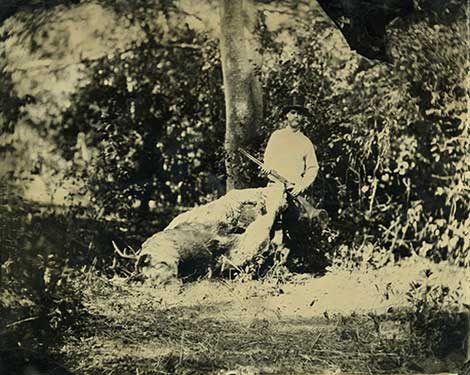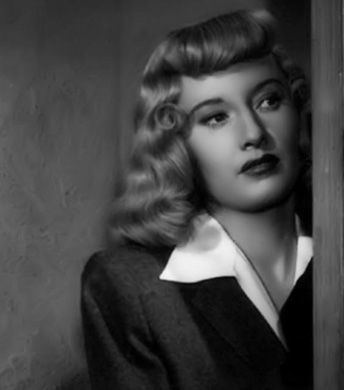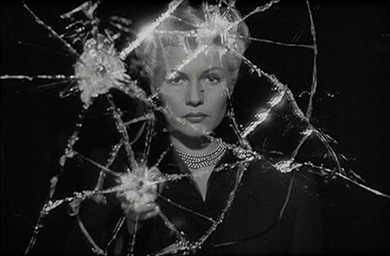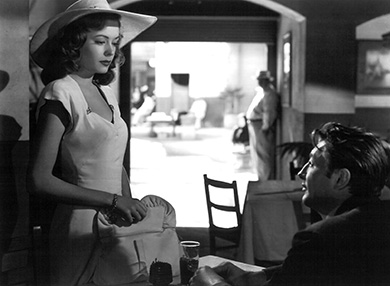


She’s in trouble, she says, and needs his help. He hesitates a second while his brain tries to work. Whatever her problem is — something about her husband working her over, the sick bastard — she can take care of herself, from the looks of her. But hello, the looks of her: those long legs, those tremulous lips, those wounded eyes. This dame isn’t in trouble, she is trouble, his brain shouts — but those eyes, those eyes. He’s way past listening to his brain. The only sound he can hear is her voice, whispering that she needs him, wants him, can’t live without him. And if his brain turns out to be right, if she ends up dragging him down into depravity, madness and murder, well, tough. If there was ever a thing worth going straight to hell for, she’s it.

Or was. In the restless middle of the 20th century, the femme fatale, the dark queen of film noir, jolted the silver screen with an electric sexuality and lethal cunning it had never seen before. She smoldered, she coveted, she hated, she schemed and, above all, she manipulated the men in her life — alternately offering and withholding the promise of love and a mind-blowing screw, playing the poor saps like puppets as the moment required. Along the way, she provided a group of gifted, intrepid Hollywood actresses a chance to shine in a way few of their rivals ever did or could, which is to say darkly: Barbara Stanwyck in Double Indemnity (1944), Lana Turner in The Postman Always Rings Twice (1946), Rita Hayworth in Gilda (1946) and The Lady from Shanghai (1947), Jane Greer in Out of the Past (1947) — unforgettable performances all, in every case a career zenith.
It was Stanwyck who scored the series’ first major triumph. (Mary Astor claimed the territory first, as the poisonous Brigid O’Shaughnessy in 1941’s The Maltese Falcon, but lacked the requisite sex appeal and, perhaps in consequence, enough screen time to make a lasting impression.) Stanwyck’s smoky-voiced Phyllis Dietrichson greets Walter Neff (Fred MacMurray), an insurance salesman who fancies himself a fast talker, wearing what Neff calls “a honey of an anklet,” her shapely leg strategically outstretched for its display. Before he knows it — and he knows so little, until it’s too late — he’s her slave:
Phyllis: Mr. Neff, why don’t you drop by tomorrow evening about eight-thirty. He’ll be in then.
Walter: Who?
Phyllis: My husband. You were anxious to talk to him, weren’t you?
Walter: Yeah, I was, but I’m sort of getting over the idea, if you know what I mean.
Phyllis: There’s a speed limit in this state, Mr. Neff. Forty-five miles an hour.
Walter: How fast was I going, officer?
Phyllis: I’d say around ninety.
In due course, Walter and his fellow chumps are forced to concede how fully they’ve been drawn into the black widow’s web, but even then they’re powerless to resist. The erotic charge between the woman and her man trumps all else, even when they both recognize it as a species of death ray. The genre reached its doom-filled pinnacle in Jacques Tourneur’s Out of the Past, in which Robert Mitchum’s square-jawed Jeff Bailey comes to fatalistic terms with his inability to separate himself from Kathie Moffat (Greer), the sultry viper who has absconded with a small fortune belonging to the vicious gangster (Kirk Douglas) now pursuing them both.
Kathie: I didn’t know what I was doing. I didn’t know anything except how much I hated him. But I didn’t take anything. I didn’t, Jeff. Don’t you believe me?
Jeff: Baby, I don’t care.
And later:
Kathie: Don’t you see you’ve only me to make deals with now?
Jeff: Build my gallows high, baby.

These immortal exchanges, viewed on DVD or late-night cable, still make the hairs on your arm prickle and point. Among her many singular contributions, the femme fatale enabled a cut-the-crap directness between men and women that’s virtually extinct in contemporary American cinema, not only in romantic comedies but in dramas as well, both of which thrive on miscommunication between the sexes. On today’s big screen, couples talk around and past each other; in the best of film noir, femme fatales and the men they captivate inevitably arrive at a searing soul-gaze that reveals their shared abyss. “We’re both rotten,” Phyllis tells Walter. “Only you’re a little more rotten,” he shoots back, but she has made her point. For all her lying, the femme fatale was a truth-teller, a bad woman whose real crime was to introduce a man to his own innate badness.
And then she was gone. By the early 1950s, the femme fatale all but disappeared from the big screen, displaced by the politely swooning housewives of Douglas Sirk and, later, empowered ass-kickers like Faye Dunaway in Bonnie and Clyde. (More recently, Angelina Jolie in leather-clad Lara Croft mode has borrowed some of the femme fatale’s arachnid allure, but unlike her cinematic ancestors, none of Jolie’s bad-girl characters needs a man to do her dirty work for her. She simply picks up a high-powered automatic weapon and does it herself.) And although the femme fatale occasionally flickered to life in the decades to come — in homages like 1981’s Body Heat (with Kathleen Turner in a scintillating big-screen debut) and 1994’s The Last Seduction (with Linda Fiorentino), sensationalist hybrids like 1992’s Basic Instinct (with Sharon Stone), genre spoofs like 1993’s Fatal Beauty (with Sean Young) and the rare fresh take on the archetype (1995’s To Die For, with Nicole Kidman) — she was essentially dead.
And she still is. When we turn on our TV sets this weekend to watch the annual Academy Award broadcast, we won’t see anything that truly fits the femme fatale archetype. Natalie Portman in Black Swan? Not even close. As the sabotaging mother in The Fighter, Melissa Leo is getting warmer, but not really. Jacki Weaver as the criminal matriarch Janine “Smurf” Cody in the Aussie drama Animal Kingdom is warmer still, but her sex appeal is nil. Perhaps the closest thing to a femme fatale among the actress nominees is 14-year-old Mattie Ross (Hailee Steinfeld) in the Coen Brothers’ True Grit; she’s out for blood, after all, and enlists the help of two men (Jeff Bridges and Matt Damon) to make it flow. But despite the briefest of hints of sexual spark between Mattie and Damon’s goofy Texas Ranger, the film’s erotic temperature is close to freezing. And in the end it’s Mattie, not the men she’s hired, who pulls the most important trigger.

What killed the femme fatale? There are several likely suspects — Hollywood, the movie going public, the changing times — but as Philip Marlowe knew, solving any murder comes down to the question of motive. The emotional core of that motive, I think, was a growing queasiness with misogyny, noxious whiffs of which have trailed the femme fatale since her creation by the male writers of hard-boiled fiction, in particular the trinity of Dashiell Hammett, Raymond Chandler and James M. Cain. There’s no denying that much of their work was occasionally and perhaps even fundamentally sexist, blowing up the stereotype of “feminine wiles” to almost comically sinister proportions. These writers’ heirs and acolytes, from Ross Macdonald to Mickey Spillane, took up where they left off. “It seemed to me then that evil was a female quality, a poison that women secreted and transmitted to men like disease,” Macdonald’s detective Lew Archer ruminates in his first outing, 1949’s The Moving Target. (Archer’s sexual politics, along with his understanding of human nature, would evolve considerably; by his final adventure, 1976’s The Blue Hammer, Archer’s sense of evil, if it still existed at all, was certainly without gender.)
But for every argument against the femme fatale as politically retrograde, there’s a counterargument for her as protofeminist forerunner. The femme fatale isn’t passive, waiting for her life to improve on its own. Instead she takes the initiative, attacking the problem with nerve, drive and intelligence. Yes, she uses cat’s-paws, rather than her own paws, to accomplish her goals. But whose fingerprints do you want on the smoking gun, yours or someone else’s? Yes, she uses her sexual power over a man to get what she wants, but power is power. She is the actor, he the acted upon. It’s she who controls her destiny, for better or worse.
And if the gallows is to be built high, at least she can claim she built it herself.

